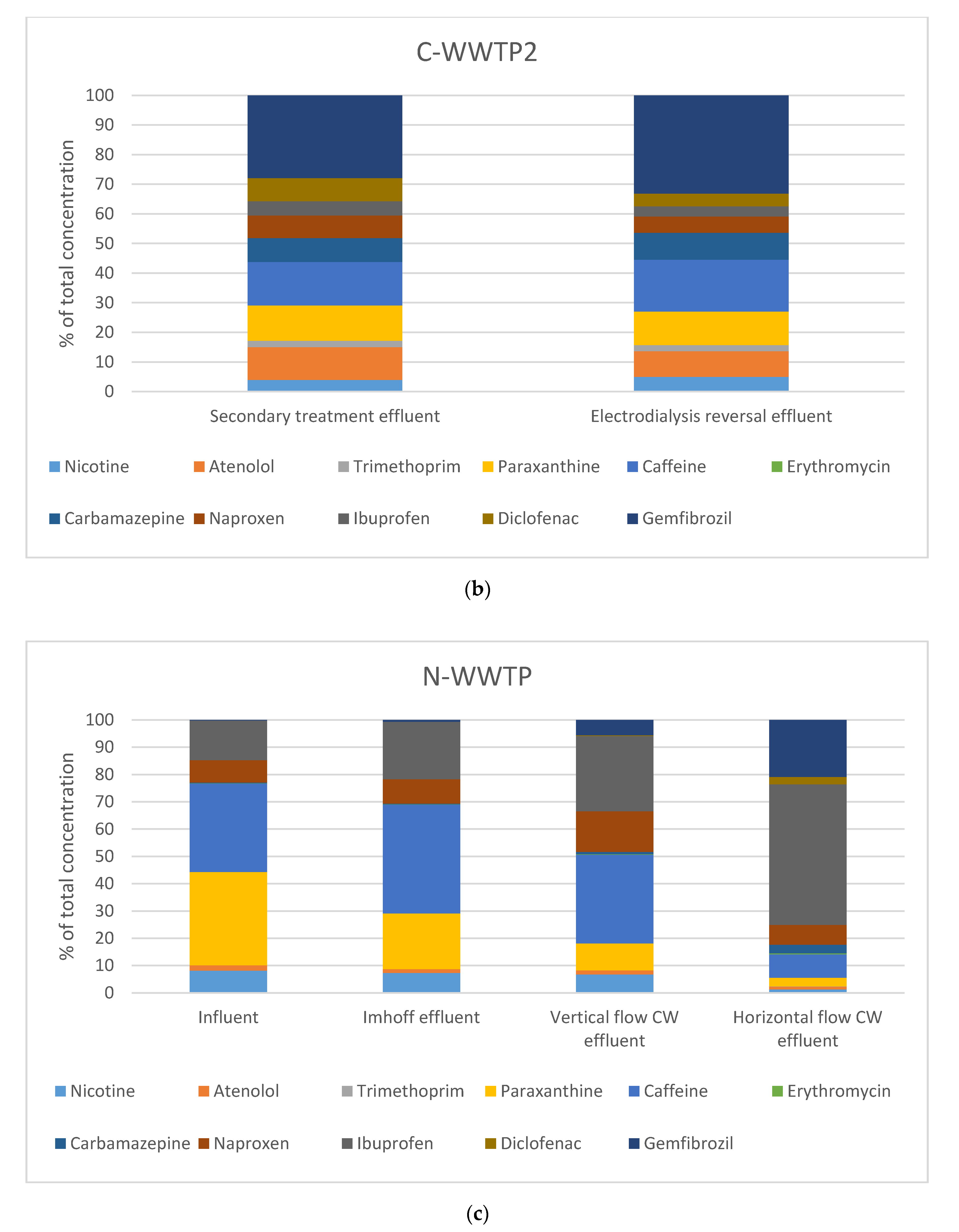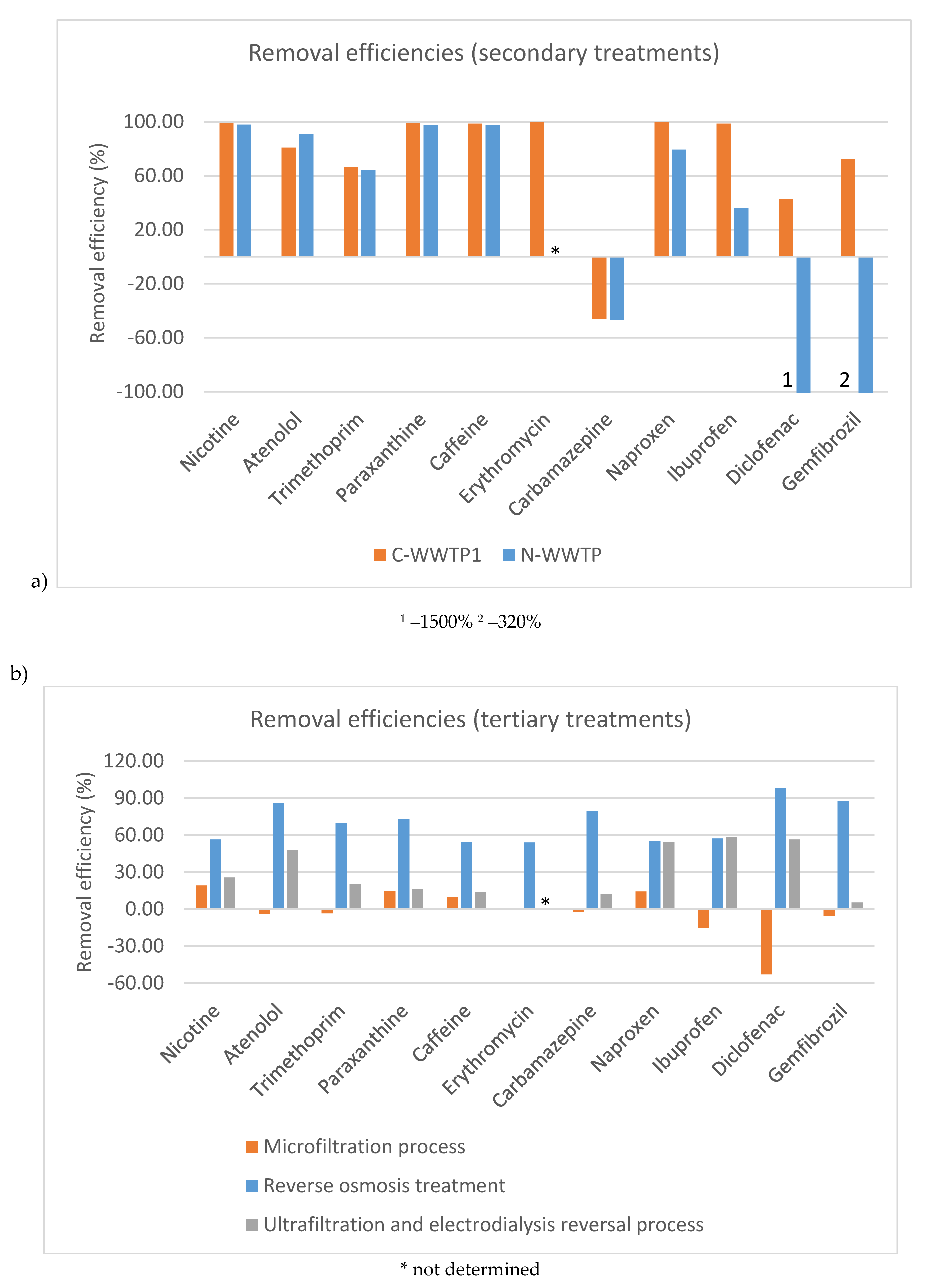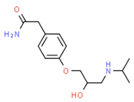A Survey of the Presence of Pharmaceutical Residues in Wastewaters. Evaluation of Their Removal using Conventional and Natural Treatment Procedures
Abstract
:1. Introduction
2. Materials and Methods
2.1. Materials
2.2. Sample Collection
2.3. Analytical Methodology
3. Results and Discussion
3.1. Occurrence and Concentrations of Target Pharmaceuticals
3.1.1. Conventional Treatment WWTPs
3.1.2. Natural Treatment WWTP
3.2. Removal of Target Pharmaceuticals
3.2.1. Conventional Treatment WWTPs
3.2.2. Natural Treatment WWTP
3.2.3. Comparison between Conventional and Natural Purification Treatments
4. Conclusions
Supplementary Materials
Author Contributions
Funding
Acknowledgments
Conflicts of Interest
References
- Martínez, S.; Suay, R.; Moreno, J.; Segura, M.L. Reuse of tertiary municipal wastewater effluent for irrigation of Cucumis melo L. Irrig. Sci. 2013, 31, 661–672. [Google Scholar] [CrossRef]
- Martínez-Alcalá, I.; Pellicer-Martínez, F.; Fernández-López, C. Pharmaceutical grey water footprint: Accounting, influence of wastewater treatment plants and implications of the reuse. Water Res. 2018, 135, 278–287. [Google Scholar] [CrossRef]
- Barceló, D.; de Alda, M. Contaminación y calidad química del agua: El problema de los contaminantes emergentes. In Jornadas De Presentación De Resultados: El Estado Ecológico De Las Masas De Agua. Panel Científico-Técnico De Seguimiento De La Política De Aguas; Fundación Nueva Cultura del Agua PANEL CIENTÍFICO-TÉCNICO DE SEGUIMIENTO DE LA POLÍTICA DE AGUAS Convenio Universidad de Sevilla-Ministerio de Medio Ambiente: Seville, Spain, 2008. [Google Scholar]
- Jones, O.A.H.; Voulvoulis, N.; Lester, J.N. Human Pharmaceuticals in the Aquatic Environment a Review. Environ. Technol. 2001, 22, 1383–1394. [Google Scholar] [CrossRef] [PubMed]
- Hernando, M.D.; Mezcua, M.; Fernández-Alba, A.R.; Barceló, D. Environmental risk assessment of pharmaceutical residues in wastewater effluents, surface waters and sediments. Talanta 2006, 69, 334–342. [Google Scholar] [CrossRef]
- Zhou, J.L.; Zhang, Z.L.; Banks, E.; Grover, D.; Jiang, J.Q. Pharmaceutical residues in wastewater treatment works effluents and their impact on receiving river water. J. Hazard. Mater. 2009, 166, 655–661. [Google Scholar] [CrossRef]
- Fatta-Kassinos, D.; Meric, S.; Nikolaou, A. Pharmaceutical residues in environmental waters and wastewater: Current state of knowledge and future research. Anal. Bioanal. Chem. 2011, 399, 251–275. [Google Scholar] [CrossRef]
- Gurke, R.; Rößler, M.; Marx, C.; Diamond, S.; Schubert, S.; Oertel, R.; Fauler, J. Occurrence and removal of frequently prescribed pharmaceuticals and corresponding metabolites in wastewater of a sewage treatment plant. Sci. Total Environ. 2015, 532, 762–770. [Google Scholar] [CrossRef] [PubMed]
- Loos, R.; Marinov, D.; Sanseverino, I.; Napierska, D.; Lettieri, T. Review of the 1st Watch List under the Water Framework Directive and recommendations for the 2nd Watch List; European Commission: Luxembourg, 2018. [Google Scholar]
- Greenham, R.T.; Miller, K.Y.; Tong, A. Removal efficiencies of top-used pharmaceuticals at sewage treatment plants with various technologies. J. Environ. Chem. Eng. 2019, 7, 103294. [Google Scholar] [CrossRef]
- Botero-Coy, A.M.; Martínez-Pachón, D.; Boix, C.; Rincón, R.J.; Castillo, N.; Arias-Marín, L.P.; Manrique-Losada, L.; Torres-Palma, R.; Moncayo-Lasso, A.; Hernández, F. An investigation into the occurrence and removal of pharmaceuticals in Colombian wastewater. Sci. Total Environ. 2018, 642, 842–853. [Google Scholar] [CrossRef]
- Asimakopoulos, A.G.; Kannan, P.; Higgins, S.; Kannan, K. Determination of 89 drugs and other micropollutants in unfiltered wastewater and freshwater by LC-MS/MS: An alternative sample preparation approach. Anal. Bioanal. Chem. 2017, 409, 6205–6225. [Google Scholar] [CrossRef] [PubMed]
- Kaplan, S. Review: Pharmacological pollution in water. Crit. Rev. Environ. Sci. Technol. 2013, 43, 1074–1116. [Google Scholar] [CrossRef]
- Wang, J.; Wang, S. Removal of pharmaceuticals and personal care products (PPCPs) from wastewater: A review. J. Environ. Manag. 2016, 182, 620–640. [Google Scholar] [CrossRef]
- Crites, R.W.; Middlebrooks, E.J.; Bastian, R.K. Natural Wastewater Treatment Systems, 2nd ed.; CRC Press: Boca Raton, FL, USA, 2014; ISBN 9781466583269. [Google Scholar]
- Matamoros, V.; Rodríguez, Y.; Albaigés, J. A comparative assessment of intensive and extensive wastewater treatment technologies for removing emerging contaminants in small communities. Water Res. 2016, 88, 777–785. [Google Scholar] [CrossRef] [PubMed]
- Guedes-Alonso, R.; Montesdeoca-Esponda, S.; Herrera-Melián, J.A.; Rodríguez-Rodríguez, R.; Ojeda-González, Z.; Landívar-Andrade, V.; Sosa-Ferrera, Z.; Santana-Rodríguez, J.J. Pharmaceutical and personal care product residues in a macrophyte pond-constructed wetland treating wastewater from a university campus: Presence, removal and ecological risk assessment. Sci. Total Environ. 2020, 703, 135596. [Google Scholar] [CrossRef]
- Durán-Álvarez, J.C.; Sánchez, Y.; Prado, B.; Jiménez, B. The transport of three emerging pollutants through an agricultural soil irrigated with untreated wastewater. J. Water Reuse Desalin. 2014, 4, 9–17. [Google Scholar] [CrossRef] [Green Version]
- Afonso-Olivares, C.; Sosa-Ferrera, Z.; Santana-Rodríguez, J.J. Occurrence and environmental impact of pharmaceutical residues from conventional and natural wastewater treatment plants in Gran Canaria (Spain). Sci. Total Environ. 2017, 599–600, 934–943. [Google Scholar] [CrossRef]
- Rodriguez-Narvaez, O.M.; Peralta-Hernandez, J.M.; Goonetilleke, A.; Bandala, E.R. Treatment technologies for emerging contaminants in water: A review. Chem. Eng. J. 2017, 323, 361–380. [Google Scholar] [CrossRef] [Green Version]
- Oller, I.; Miralles-Cuevas, S.; Aguera, A.; Malato, S. Monitoring and Removal of Organic Micro-contaminants by Combining Membrane Technologies with Advanced Oxidation Processes. Curr. Org. Chem. 2018, 22, 1103–1119. [Google Scholar] [CrossRef]
- Arola, K.; Ward, A.; Mänttäri, M.; Kallioinen, M.; Batstone, D. Transport of pharmaceuticals during electrodialysis treatment of wastewater. Water Res. 2019, 161, 496–504. [Google Scholar] [CrossRef] [PubMed]
- Ibekwe, A.M.; Murinda, S.E. Linking microbial community composition in treated wastewater with water quality in distribution systems and subsequent health effects. Microorganisms 2019, 7, 660. [Google Scholar] [CrossRef] [PubMed] [Green Version]
- Rodriguez-Gil, J.L.; San Sebastián Sauto, J.; González-Alonso, S.; Sánchez Sanchez, P.; Valcarcel, Y.; Catalá, M. Development of cost-effective strategies for environmental monitoring of irrigated areas in Mediterranean regions: Traditional and new approaches in a changing world. Agric. Ecosyst. Environ. 2013, 181, 41–49. [Google Scholar] [CrossRef]
- Sun, Q.; Lv, M.; Hu, A.; Yang, X.; Yu, C.P. Seasonal variation in the occurrence and removal of pharmaceuticals and personal care products in a wastewater treatment plant in Xiamen, China. J. Hazard. Mater. 2014, 277, 69–75. [Google Scholar] [CrossRef] [PubMed]
- Ekpeghere, K.I.; Sim, W.J.; Lee, H.J.; Oh, J.E. Occurrence and distribution of carbamazepine, nicotine, estrogenic compounds, and their transformation products in wastewater from various treatment plants and the aquatic environment. Sci. Total Environ. 2018, 640–641, 1015–1023. [Google Scholar] [CrossRef]
- Rico, A.; Arenas-Sánchez, A.; Alonso-Alonso, C.; López-Heras, I.; Nozal, L.; Rivas-Tabares, D.; Vighi, M. Identification of contaminants of concern in the upper Tagus river basin (central Spain). Part 1: Screening, quantitative analysis and comparison of sampling methods. Sci. Total Environ. 2019, 666, 1058–1070. [Google Scholar] [CrossRef] [PubMed]
- Simó Miñana, J. Use of prescription drugs in Spain and Europe. Aten. Primaria 2012, 44, 335–347. [Google Scholar] [CrossRef] [Green Version]
- Camacho-Muñoz, D.; Martín, J.; Santos, J.L.; Aparicio, I.; Alonso, E. Occurrence, temporal evolution and risk assessment of pharmaceutically active compounds in Doñana Park (Spain). J. Hazard. Mater. 2010, 183, 602–608. [Google Scholar] [CrossRef]
- Gabarrón, S.; Gernjak, W.; Valero, F.; Barceló, A.; Petrovic, M.; Rodríguez-Roda, I. Evaluation of emerging contaminants in a drinking water treatment plant using electrodialysis reversal technology. J. Hazard. Mater. 2016, 309, 192–201. [Google Scholar] [CrossRef]
- Sundaravadivel, M.; Vigneswaran, S. Constructed wetlands for wastewater treatment. Crit. Rev. Environ. Sci. Technol. 2001, 31, 351–409. [Google Scholar] [CrossRef]
- Scholz, M.; Lee, B. Constructed wetlands: A review. Int. J. Environ. Stud. 2005, 62, 421–447. [Google Scholar] [CrossRef]
- Jelic, A.; Gros, M.; Ginebreda, A.; Cespedes-Sánchez, R.; Ventura, F.; Petrovic, M.; Barcelo, D. Occurrence, partition and removal of pharmaceuticals in sewage water and sludge during wastewater treatment. Water Res. 2011, 45, 1165–1176. [Google Scholar] [CrossRef]
- Hai, F.; Yang, S.; Asif, M.; Sencadas, V.; Shawkat, S.; Sanderson-Smith, M.; Gorman, J.; Xu, Z.-Q.; Yamamoto, K. Carbamazepine as a Possible Anthropogenic Marker in Water: Occurrences, Toxicological Effects, Regulations and Removal by Wastewater Treatment Technologies. Water 2018, 10, 107. [Google Scholar] [CrossRef] [Green Version]
- Clara, M.; Strenn, B.; Gans, O.; Martinez, E.; Kreuzinger, N.; Kroiss, H. Removal of selected pharmaceuticals, fragrances and endocrine disrupting compounds in a membrane bioreactor and conventional wastewater treatment plants. Water Res. 2005, 39, 4797–4807. [Google Scholar] [CrossRef] [PubMed]
- Tadkaew, N.; Hai, F.I.; McDonald, J.A.; Khan, S.J.; Nghiem, L.D. Removal of trace organics by MBR treatment: The role of molecular properties. Water Res. 2011, 45, 2439–2451. [Google Scholar] [CrossRef] [Green Version]
- Luo, W.; Hai, F.I.; Kang, J.; Price, W.E.; Guo, W.; Ngo, H.H.; Yamamoto, K.; Nghiem, L.D. Effects of salinity build-up on biomass characteristics and trace organic chemical removal: Implications on the development of high retention membrane bioreactors. Bioresour. Technol. 2015, 177, 274–281. [Google Scholar] [CrossRef] [PubMed] [Green Version]
- Tiwari, B.; Sellamuthu, B.; Ouarda, Y.; Drogui, P.; Tyagi, R.D.; Buelna, G. Review on fate and mechanism of removal of pharmaceutical pollutants from wastewater using biological approach. Bioresour. Technol. 2017, 224, 1–12. [Google Scholar] [CrossRef] [PubMed] [Green Version]
- Jones, O.A.H.; Voulvoulis, N.; Lester, J.N. Human pharmaceuticals in wastewater treatment processes. Crit. Rev. Environ. Sci. Technol. 2005, 35, 401–427. [Google Scholar] [CrossRef]
Sample Availability: Samples of the compounds are not available from the authors. |




| Drug Family | Compound | CAS No. | Molecular Weight (g/mole) | Structure |
|---|---|---|---|---|
| Stimulants | Nicotine | 54-11-5 | 162.230 |  |
| Caffeine | 58-08-2 | 194.191 |  | |
| Paraxanthine | 611-59-6 | 180.164 |  | |
| Anti-inflammatories | Naproxen | 22204-53-1 | 230.260 |  |
| Ibuprofen | 15687-27-1 | 206.281 |  | |
| Diclofenac | 15307-86-5 | 296.149 |  | |
| Lipid regulators | Gemfibrozil | 25812-30-0 | 250.333 |  |
| Anti-hypertensives | Atenolol | 29122-68-7 | 266.336 |  |
| Anti-convulsants | Carbamazepine | 298-46-4 | 236.269 |  |
| Antibiotics | Trimethoprim | 738-70-5 | 290.318 |  |
| Erythromycin | 114-07-8 | 733.927 |  |
| (a) | ||||||||
| Compound | Point A1 | Point A2 | Point A3 | Point A4 | ||||
| Median Concentration (min–max Concentration) (µg·L−1) | Positive Results (%) | Median Concentration (min–max Concentration) (ng·L−1) | Positive Results (%) | Median Concentration (min–max Concentration) (ng·L−1) | Positive Results (%) | Median Concentration (min–max Concentration) (ng·L−1) | Positive Results (%) | |
| Nicotine | 14.179 (0.005–45.82) | 89.5 | 0.151 (0.064–0.449) | 88.9 | 0.136 (0.002–0.586) | 86.7 | 0.065 (0.001–0.251) | 87.5 |
| Atenolol | 1.134 (0.354–2.899) | 84.2 | 0.218 (0.006–0.643) | 83.3 | 0.287 (0.007–1.949) | 86.7 | 0.061 (0.001–0.088) | 81.3 |
| Trimethoprim | 0.231 (0.053–0.658) | 84.2 | 0.077 (0.034–0.157) | 77.8 | 0.071 (0.029–0.169) | 73.3 | 0.021 (0.013–0.054) | 75.0 |
| Paraxanthine | 47.869 (12.46–95.63) | 89.5 | 0.518 (0.101–6.900) | 88.9 | 0.425 (0.036–5.901) | 86.7 | 0.117 (0.031–1.262) | 81.3 |
| Caffeine | 36.495 (15.47–72.62) | 89.5 | 0.589 (0.095–2.499) | 88.9 | 0.663 (0.120–2.705) | 80.0 | 0.169 (0.051–1.943) | 87.5 |
| Erythromycin | 0.083 (0.070–0.094) | 15.8 | 0.067 (0.043–0.090) | 11.1 | 0.052 (0.044–0.709) | 26.7 | 0.047 (0.047–0.073) | 25.0 |
| Carbamazepine | 0.146 (0.045–2.394) | 89.5 | 0.240 (0.137–2.597) | 88.9 | 0.234 (0.078–4.687) | 86.7 | 0.052 (0.013–0.158) | 87.5 |
| Naproxen | 27.333 (4.910–521.7) | 84.2 | 0.172 (0.072–1.528) | 66.7 | 0.282 (0.057–1.311) | 73.3 | 0.102 (0.011–0.584) | 68.8 |
| Ibuprofen | 19.894 (0.128–147.5) | 84.2 | 0.208 (0.047–1.585) | 77.8 | 0.214 (0.009–1.184) | 80.0 | 0.139 (0.005–1.751) | 56.3 |
| Diclofenac | 0.139 (0.006–0.708) | 47.4 | 0.117 (0.007–0.404) | 77.8 | 0.152 (0.034–0.288) | 73.3 | 0.024 (0.006–0.115) | 37.5 |
| Gemfibrozil | 3.353 (0.053–40.63) | 84.2 | 0.729 (0.012–3.602) | 83.3 | 0.598 (0.033–2.865) | 80.0 | 0.103 (0.004–0.485) | 56.3 |
| (b) | ||||||||
| Point B1 | Point B2 | |||||||
| Compound | Median Concentration (min–max Concentration) (µg·L−1) | Positive Results (%) | Median Concentration (min–max Concentration) (ng·L−1) | Positive Results (%) | ||||
| Nicotine | 0.103 (0.038–0.228) | 100 | 0.105 (0.047–0.343) | 100 | ||||
| Atenolol | 0.286 (0.001–0.521) | 100 | 0.184 (0.167–0.234) | 85.7 | ||||
| Trimethoprim | 0.055 (0.014–0.130) | 100 | 0.043 (0.014–0.074) | 100 | ||||
| Paraxanthine | 0.310 (0.037–1.256) | 100 | 0.241 (0.031–2.634) | 100 | ||||
| Caffeine | 0.378 (0.058–0.817) | 100 | 0.369 (0.050–2.749) | 100 | ||||
| Erythromycin | nd * | 0.0 | nd * | 0.0 | ||||
| Carbamazepine | 0.209 (0.148–0.312) | 85.7 | 0.193 (0.107–0.327) | 85.7 | ||||
| Naproxen | 0.198 (0.150–0.237) | 57.1 | 0.116 (0.077–0.555) | 57.1 | ||||
| Ibuprofen | 0.125 (0.027–0.173) | 100 | 0.074 (0.008–0.969) | 85.7 | ||||
| Diclofenac | 0.202 (0.070–0.280) | 85.7 | 0.091 (0.027–0.139) | 85.7 | ||||
| Gemfibrozil | 0.723 (0.392–1.098) | 85.7 | 0.701 (0.306–0.883) | 85.7 | ||||
| (c) | ||||||||
| Point C1 | Point C2 | Point C3 | Point C4 | |||||
| Compound | Median Concentration (min–max Concentration) (µg·L−1) | Positive Results (%) | Median Concentration (min–max Concentration) (ng·L−1) | Positive Results (%) | Median Concentration (min–max Concentration) (ng·L−1) | Positive Results (%) | Median Concentration (min–max Concentration) (ng·L−1) | Positive Results (%) |
| Nicotine | 9.606 (6.449–63.94) | 89.5 | 7.651 (0.194–37.29) | 89.5 | 3.515 (0.134–12.70) | 88.9 | 0.245 (0.086–1.077) | 81.8 |
| Atenolol | 2.195 (0.757–10.00) | 84.2 | 1.402 (0.037–2.396) | 89.5 | 0.742 (0.072–1.990) | 83.3 | 0.198 (0.082–0.753) | 81.8 |
| Trimethoprim | 0.034 (0.017–2.166) | 63.2 | 0.031 (0.013–0.531) | 68.4 | 0.020 (0.014–0.674) | 50.0 | 0.018 (0.015–0.088) | 36.4 |
| Paraxanthine | 40.050 (9.619–85.77) | 89.5 | 21.243 (6.867–39.84) | 89.5 | 5.084 (0.143–30.56) | 88.9 | 0.596 (0.151–2.480) | 81.8 |
| Caffeine | 37.888 (10.39–126.4) | 89.5 | 41.497 (11.16–65.22) | 89.5 | 16.771 (0.382–47.58) | 88.9 | 1.633 (0.261–5.595) | 81.8 |
| Erythromycin | 0.101 (0.071–0.131) | 10.5 | 0.066 (0.025–0.107) | 10.5 | 0.081 (0.045–5.346) | 33.3 | 0.064 (0.063–0.066) | 18.2 |
| Carbamazepine | 0.299 (0.039–1.306) | 89.5 | 0.306 (0.081–0.969) | 89.5 | 0.432 (0.069–7.797) | 88.9 | 0.604 (0.247–1.009) | 81.8 |
| Naproxen | 9.653 (0.911–320.1) | 84.2 | 9.383 (2.581–177.0) | 84.2 | 7.713 (0.644–77.47) | 83.3 | 1.397 (0.310–5.179) | 81.8 |
| Ibuprofen | 16.942 (4.378–121.4) | 84.2 | 21.886 (5.331–133.7) | 84.2 | 14.209 (0.931–43.97) | 83.3 | 9.803 (6.658–18.76) | 81.8 |
| Diclofenac | 0.035 (0.008–0.055) | 21.1 | 0.028 (0.007–0.718) | 47.4 | 0.139 (0.024–0.591) | 61.1 | 0.525 (0.020–2.813) | 81.8 |
| Gemfibrozil | 0.222 (0.001–16.11) | 73.7 | 0.647 (0.006–5.632) | 78.9 | 2.904 (0.112–7.403) | 83.3 | 3.972 (1.104–7.670) | 81.8 |
© 2020 by the authors. Licensee MDPI, Basel, Switzerland. This article is an open access article distributed under the terms and conditions of the Creative Commons Attribution (CC BY) license (http://creativecommons.org/licenses/by/4.0/).
Share and Cite
Guedes-Alonso, R.; Montesdeoca-Esponda, S.; Pacheco-Juárez, J.; Sosa-Ferrera, Z.; Santana-Rodríguez, J.J. A Survey of the Presence of Pharmaceutical Residues in Wastewaters. Evaluation of Their Removal using Conventional and Natural Treatment Procedures. Molecules 2020, 25, 1639. https://doi.org/10.3390/molecules25071639
Guedes-Alonso R, Montesdeoca-Esponda S, Pacheco-Juárez J, Sosa-Ferrera Z, Santana-Rodríguez JJ. A Survey of the Presence of Pharmaceutical Residues in Wastewaters. Evaluation of Their Removal using Conventional and Natural Treatment Procedures. Molecules. 2020; 25(7):1639. https://doi.org/10.3390/molecules25071639
Chicago/Turabian StyleGuedes-Alonso, R., S. Montesdeoca-Esponda, J. Pacheco-Juárez, Z. Sosa-Ferrera, and J. J. Santana-Rodríguez. 2020. "A Survey of the Presence of Pharmaceutical Residues in Wastewaters. Evaluation of Their Removal using Conventional and Natural Treatment Procedures" Molecules 25, no. 7: 1639. https://doi.org/10.3390/molecules25071639
APA StyleGuedes-Alonso, R., Montesdeoca-Esponda, S., Pacheco-Juárez, J., Sosa-Ferrera, Z., & Santana-Rodríguez, J. J. (2020). A Survey of the Presence of Pharmaceutical Residues in Wastewaters. Evaluation of Their Removal using Conventional and Natural Treatment Procedures. Molecules, 25(7), 1639. https://doi.org/10.3390/molecules25071639








